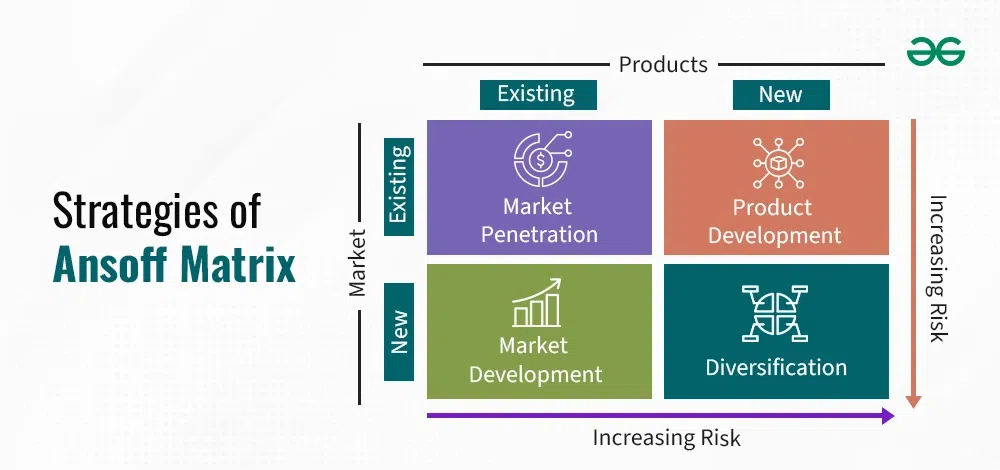Strategies of Ansoff Matrix
Last Updated :
18 Apr, 2024
The 1957 Ansoff Matrix, developed by Igor Ansoff, helps firms analyse and plan growth plans. It describes four growth strategies: Market Penetration, Market Development, Product Development, and Diversification. Market Penetration involves offering more products or services to current markets to increase market share. Market Development is entering new markets with existing products or services to increase the client base. Product Development meets changing client needs by generating new items or services for current markets. Diversification, the riskiest method, involves entering new markets with new products or services to grow and diversify revenue. Businesses can use the Ansoff Matrix to evaluate the risks and benefits of each strategy and make decisions that match their goals and market conditions.

Geeky Takeaways:
- Market Penetration involves increasing the sales volume of established products in existing markets.
- Market Development includes the introduction of established products into new markets.
- Product Development involves the introduction of novel products into established markets.
- Diversification involves the introduction of fresh products or services into unexplored markets.
- The Ansoff Matrix facilitates the evaluation of development strategy risks and rewards.
What is the Ansoff Matrix?
The Ansoff Matrix, also known as the Product-Market Expansion Grid, is a strategic planning tool that helps businesses evaluate and plan their growth strategies. It was introduced by Russian-American mathematician and business theorist Igor Ansoff in 1957. The matrix is designed to guide companies in making decisions about their product and market growth based on two key dimensions: products and markets.
Strategies of Ansoff Matrix
The Ansoff Matrix consists of four growth strategies, each representing a different combination of new and existing products and markets. These strategies are:
|
|
Market Penetration
|
Market Development
|
Product Development
|
Diversification
|
|
Objective
|
Increase market share with existing products in existing markets. |
Introduce existing products to new markets or customer segments. |
Introduce new products to existing markets. |
Explore entirely new markets with new products that the company has not offered before. |
|
Approach
|
Focus on selling more of the current products to the existing customer base or attracting new customers within the current market. |
Expand the reach of current products to new geographic areas or target different customer segments. |
Innovate and develop new products or improve existing ones to meet the needs of the current market. |
Acquiring or merging with other companies, investing in research and development for new products, or entering entirely different industries. |
|
Tactics
|
Price adjustment, increased marketing and advertising, loyalty programs, and improvements in product quality or features. |
Entering new regions, targeting different demographic groups, or exploring untapped market segments. |
Research and development, product diversification, and introducing variations of upgrades to existing products. |
The matrix is typically represented as a 2*2 grid, with the horizontal axis representing products (existing and new) and the vertical axis representing markets (existing and new). By plotting their growth options on this matrix, companies can visually assess and choose the most suitable strategy for their specific situation. |
1. Market Penetration
- Price Adjustments: Implementing competitive pricing strategies to attract more customers.
- Marketing Campaigns: Investing in advertising and promotional activities to enhance brand visibility and customer engagement.
- Product Enhancement: Continuously improving existing products to meet evolving customer needs and preferences.
- Distribution Expansion: Strengthening distribution channels to reach a wider audience.
2. Market Development
- Geographic expansion: Entering a new regions or countries to tap into different customer bases.
- Demographic Targeting: Identifying and targeting new customer segments within existing markets.
- Channel Diversification: Exploring new distribution channels to reach diverse customer groups.
- Strategic Partnerships: Collaborating with other businesses to access new markets.
3. Product Development
- Research and Development: Investing in innovation to create and launch new products.
- Product Differentiation: Offering unique features or functionalities to distinguish new products in the market.
- Customer Feedback: Gathering and incorporating customer insights to develop products aligned with market demands.
- Brand Extension: Leverage existing brand equity to introduce new products within the same product category.
4. Diversification
- Related Diversification: Expanding into a new business area that complements existing products or services.
- Unrelated Diversification: Venturing into entirely different industries or markets.
- Mergers and Acquisitions: Acquiring or merging with other companies to gain access to new products or markets.
- Joint Ventures: Collaborating with other businesses to enter unfamiliar markets or industries.
Successful implementation of Ansoff Matrix strategies requires a thorough understanding of the organization capabilities, market dynamics, and competitive landscape. Companies may choose to combine these strategies or implement them sequentially based on their goals, resources, and the level of risk they are willing to undertake. Regular monitoring and adjustments are crucial to ensure that the chosen strategies remain aligned with the evolving business environment.
Share your thoughts in the comments
Please Login to comment...